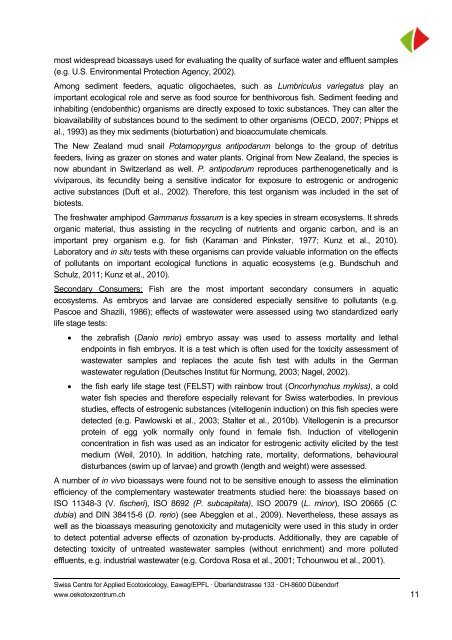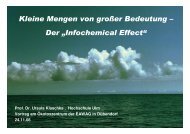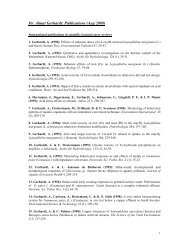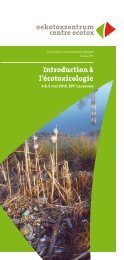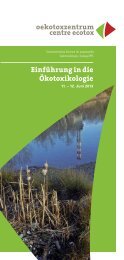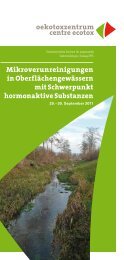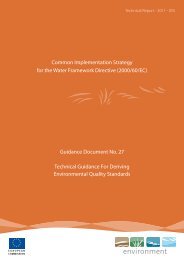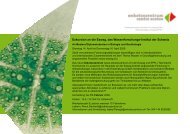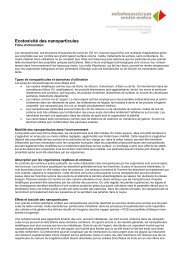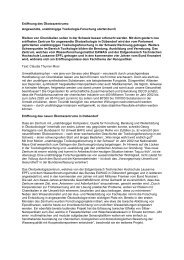Evaluation of Bioassays and Wastewater Quality ... - Oekotoxzentrum
Evaluation of Bioassays and Wastewater Quality ... - Oekotoxzentrum
Evaluation of Bioassays and Wastewater Quality ... - Oekotoxzentrum
Create successful ePaper yourself
Turn your PDF publications into a flip-book with our unique Google optimized e-Paper software.
most widespread bioassays used for evaluating the quality <strong>of</strong> surface water <strong>and</strong> effluent samples<br />
(e.g. U.S. Environmental Protection Agency, 2002).<br />
Among sediment feeders, aquatic oligochaetes, such as Lumbriculus variegatus play an<br />
important ecological role <strong>and</strong> serve as food source for benthivorous fish. Sediment feeding <strong>and</strong><br />
inhabiting (endobenthic) organisms are directly exposed to toxic substances. They can alter the<br />
bioavailability <strong>of</strong> substances bound to the sediment to other organisms (OECD, 2007; Phipps et<br />
al., 1993) as they mix sediments (bioturbation) <strong>and</strong> bioaccumulate chemicals.<br />
The New Zeal<strong>and</strong> mud snail Potamopyrgus antipodarum belongs to the group <strong>of</strong> detritus<br />
feeders, living as grazer on stones <strong>and</strong> water plants. Original from New Zeal<strong>and</strong>, the species is<br />
now abundant in Switzerl<strong>and</strong> as well. P. antipodarum reproduces parthenogenetically <strong>and</strong> is<br />
viviparous, its fecundity being a sensitive indicator for exposure to estrogenic or <strong>and</strong>rogenic<br />
active substances (Duft et al., 2002). Therefore, this test organism was included in the set <strong>of</strong><br />
biotests.<br />
The freshwater amphipod Gammarus fossarum is a key species in stream ecosystems. It shreds<br />
organic material, thus assisting in the recycling <strong>of</strong> nutrients <strong>and</strong> organic carbon, <strong>and</strong> is an<br />
important prey organism e.g. for fish (Karaman <strong>and</strong> Pinkster, 1977; Kunz et al., 2010).<br />
Laboratory <strong>and</strong> in situ tests with these organisms can provide valuable information on the effects<br />
<strong>of</strong> pollutants on important ecological functions in aquatic ecosystems (e.g. Bundschuh <strong>and</strong><br />
Schulz, 2011; Kunz et al., 2010).<br />
Secondary Consumers: Fish are the most important secondary consumers in aquatic<br />
ecosystems. As embryos <strong>and</strong> larvae are considered especially sensitive to pollutants (e.g.<br />
Pascoe <strong>and</strong> Shazili, 1986); effects <strong>of</strong> wastewater were assessed using two st<strong>and</strong>ardized early<br />
life stage tests:<br />
� the zebrafish (Danio rerio) embryo assay was used to assess mortality <strong>and</strong> lethal<br />
endpoints in fish embryos. It is a test which is <strong>of</strong>ten used for the toxicity assessment <strong>of</strong><br />
wastewater samples <strong>and</strong> replaces the acute fish test with adults in the German<br />
wastewater regulation (Deutsches Institut für Normung, 2003; Nagel, 2002).<br />
� the fish early life stage test (FELST) with rainbow trout (Oncorhynchus mykiss), a cold<br />
water fish species <strong>and</strong> therefore especially relevant for Swiss waterbodies. In previous<br />
studies, effects <strong>of</strong> estrogenic substances (vitellogenin induction) on this fish species were<br />
detected (e.g. Pawlowski et al., 2003; Stalter et al., 2010b). Vitellogenin is a precursor<br />
protein <strong>of</strong> egg yolk normally only found in female fish. Induction <strong>of</strong> vitellogenin<br />
concentration in fish was used as an indicator for estrogenic activity elicited by the test<br />
medium (Weil, 2010). In addition, hatching rate, mortality, deformations, behavioural<br />
disturbances (swim up <strong>of</strong> larvae) <strong>and</strong> growth (length <strong>and</strong> weight) were assessed.<br />
A number <strong>of</strong> in vivo bioassays were found not to be sensitive enough to assess the elimination<br />
efficiency <strong>of</strong> the complementary wastewater treatments studied here: the bioassays based on<br />
ISO 11348-3 (V. fischeri), ISO 8692 (P. subcapitata), ISO 20079 (L. minor), ISO 20665 (C.<br />
dubia) <strong>and</strong> DIN 38415-6 (D. rerio) (see Abegglen et al., 2009). Nevertheless, these assays as<br />
well as the bioassays measuring genotoxicity <strong>and</strong> mutagenicity were used in this study in order<br />
to detect potential adverse effects <strong>of</strong> ozonation by-products. Additionally, they are capable <strong>of</strong><br />
detecting toxicity <strong>of</strong> untreated wastewater samples (without enrichment) <strong>and</strong> more polluted<br />
effluents, e.g. industrial wastewater (e.g. Cordova Rosa et al., 2001; Tchounwou et al., 2001).<br />
Swiss Centre for Applied Ecotoxicology, Eawag/EPFL · Überl<strong>and</strong>strasse 133 · CH-8600 Dübendorf<br />
www.oekotoxzentrum.ch<br />
11


